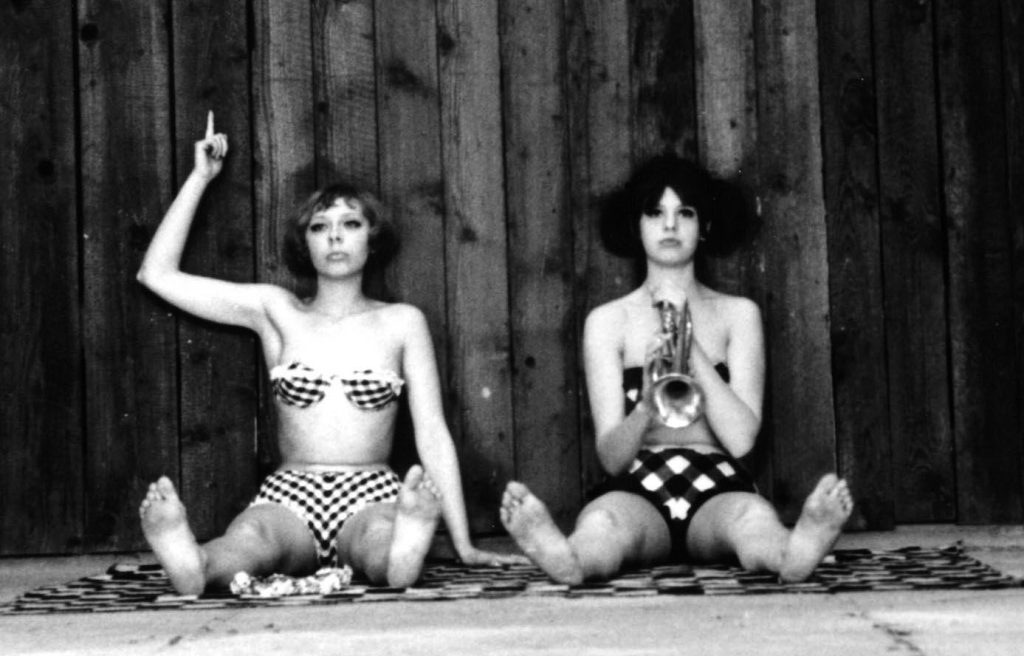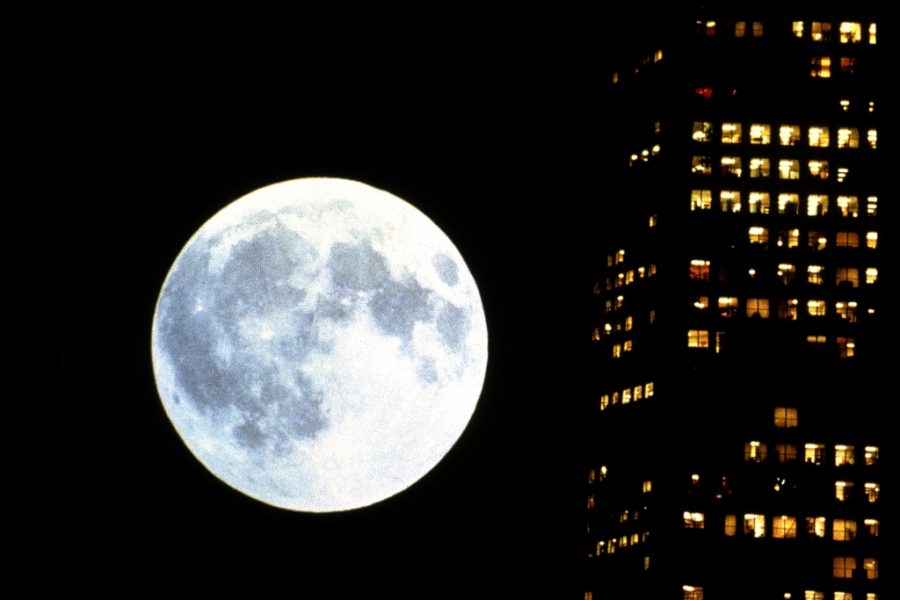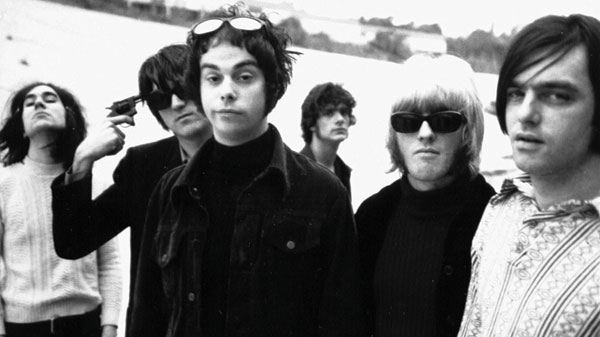Věra Chytilová’s 1966 surrealist and anarchic farce follows the misadventures of two bored and rebellious young Czech women. The women, both called Marie, revolt against a degenerate and oppressive society, attacking symbols of wealth and bourgeois culture. Daisies is a riotous, hilarious and aesthetically rich film that is widely considered one of the great works of feminist cinema.
The film was selected by artist Lucy Stein. Lucy’s work builds on an engagement with British modernist painting, feminist theory and women’s literature and includes painting, performance and film. She lives and works in Cornwall.
LUCY STEIN: INTRODUCTION
The first time I watched Daisies was in the late naughties, in winter, in Berlin. I had known about it for a long time and was often told that I was, in style and career choices, ‘very Daisies’. I felt like I’d seen it for years before I actually had. Finally, after a deeply unsatisfying night at an art event in Mitte, my friend Rosie said right that was it we were going home to watch it as she had just acquired it on DVD.
We ended up watching it in a state of inebriation five times back to back and the experience of watching it like that was instructive. Daisies disrupted our sense of time and space and we were able to concentrate very intently and eventually everything on the periphery of our senses began to take precedence over the centre. Double vision maybe.
Daisies takes you on a de-centred and anarchic journey, so all the giggles and noises and creaks and high-pitched ‘vadi? nevadi’ (meaning ‘does it matter, no it doesn’t matter’) begin to work on you in a surround-sound cinematic experience kind of way and it gets into your nervous system.
Every time I watch it now I go back into that dark and magical post-war micro-macro space of a centre that is unstable and not holding, and I feel nostalgic for my own past, drifting around a Europe on the cusp, and nostalgic for an old Europe that no longer exists, despite all the horrors and ghosts that accompany its memory.
And yet young women continue to exist. One of the central themes of Daisies is something that had struck me as a teenager in the 1990s and that is that when two young women act together a power is unleashed that spins the world a bit on its axis. An uncanniness is generated that starts to direct the narrative and strange things happen, the most obvious and common of which is that the two women start to mimic one another. Though throughout the film the women’s behaviour is purposeful and deliberate, however wanton and abandoned they may appear, it’s the feeling of a heightened, aroused, playful and slightly sinister atmosphere that Chytilova and the actresses and Ester Krumbachova, the set and costume designer, manage to evoke that makes me love it so much. Perhaps it’s the female sexuality on display, eroticism channelled through a female director subverting the male gaze, or perhaps it’s a poisonous hormonal soup that is invoked, one that many women will recognise as leading to reckless and nihilistic behaviours. Whatever it is the high-pitched giggles take me back to a place that feels familiar and dangerous.
The first scene with the creaking noises suggests that the women are marionettes, knowing puppets. Both women, played by Jitka Cerhová and Ivana Karbanová, are called Marie, presumably with a nod to the so-called virgin/whore dichotomy, that binarisation of the archetypal woman that held for millennia in Europe. The Mary/Mary of the doting virgin mother and the Magdelen, the fallen one.
The direct relationship between the sexual and reproductive power of women’s bodies, in all their elegance or abandon, and the theatre of battle and devastation, of phallic war machines and statecraft is never far from the surface in Daisies. The reliance of the latter on the former is a point that is hammered home at various moments, from the title and credit sequences to when they are punished as witches. The Maries retain their good humour throughout.
There is one scene that is uncomfortable to watch, in which the Maries emerge from the railway tunnel in a covering of soot that looks close to black face, especially as they are moving in a knock-kneed way that seems to be a double entendre on vaudeville and American minstrelry. This is in keeping with other vignettes in which they appropriate or storm the stage during popular dance routines, but usually there is a sense that they are on the outside looking in. This double entendre seems to place them inside the minstrelry act and slightly more helpless than usual, which is both touching and difficult to take.
I keep reading that this is the first feminist film but I can’t help thinking that its wit and values are more aligned with what in the eighties and nineties was coined post-feminism. Vera Chytilova herself refused to identify as a feminist, ‘preferring to define herself as a rule-breaking individual. Under the regime, feminism was often seen as a western import and a result of capitalism, ultimately superfluous in an ‘equal’ socialist society’. Perhaps this was pragmatism as much as anything, since to define herself as a feminist would have set off even more alarm bells for the Czech regime.
This reminds me of Courtney Love screaming ‘I don’t do the dishes, I throw them in the crib’, followed by ‘I am not a feminist’ on the track ‘asking for it’ in 1994. At certain points and places in history perhaps not identifying as a feminist is the most feminist position you can take.
As it was the film was banned by the regime anyway, unsurprisingly. It was labelled nihilistic and the Maries were supposedly morally bankrupt. The officials did not approve of the food wastage. Interestingly the American reviewers seemed to agree with the Czech regime’s response. Bosley Crowther described it in The New York Times as a ‘Pretentiously kookie and laboriously overblown mod farce about two playgirls who are thoroughly empty-headed. Its stabs at humor and satire simply don’t cut.’
I revisited Daisies in preparation for tonight and tomorrow, whilst cleaning the house. I placed the computer on my bed and got on with the job of picking up dirty laundry and endless toys, and my girls who are three and one were entranced. They really understood what was going on in the film. The next day Mary said “I really like Daisies. Especially the girl with the flowers in her hair and the girl with the pigtails.”
Infantalising women is about the attitude of the viewer, the gaze upon them. Infants are not dumb; they just don’t have the language to express the complexity they experience. In Daisies the women, who are definitely women and not girls, cut through complexity with wanton deadpan abandon. It takes a lot of sophistication and intelligence to be that naïve. The most frightening psychic register in the film is the scene in which they become invisible, disappeared. This I think is the only time in which the threat of panic, of latent hysteria, almost breaks through and they are not in control of their wilful abandon.
Delivered on Thursday 11 November, 2021.


